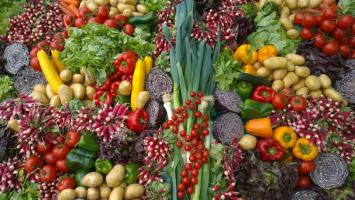
DIET & LIFESTYLE
DISCOVER HOW TO HEAL
     4 ratings, 205 likes 4 ratings, 205 likes
Customer Reviews5.00 out of 5 stars     Sign in to review this article Sign in to review this article"Amazing...I'm experiencing all of these symptoms even the emotions. At least I know why now." - Diana Manzanares,      Do you live in the Southern Hemisphere? You may need the Ayurvedic Diet for September instead. ClimateMarch's weather is unpredictable. You might step out to find wind, rain, snow or sunshine - anything can happen. There's enough warmth and sunny days to spawn the big yearly melt of snow externally as fat "melts" internally. As rivers begin gushing with ice cold water, your chest and sinuses begin oozing with phlegm. Everything feels wet. The earth is soggy and fertile, rich with possibility. You may notice moisture and puffiness in your skin, even your forehead feels cool and moist. As hibernating animals come back to life, so should you. The longer and brighter days beckon you to enjoy the sunshine. Catch it when you can - heavy clouds might be on the horizon!PsychologyThe wateriness of March has emotional repercussions as well. Psychologically, March is a month of lamentation, sadness, grief and release of deep seated emotions. Breathing exercises (pranayama), such as bhastrika and kapalabhati can flush out heaviness from the chest. As your body liquefies what has been frozen solid all winter, dreams of cool water may surface in March. As a boy, I used to dream of a whale in the black deep, far below the surface of the water, every year in March. What is lurking in the depths of your subconscious?March In Your BodyAs your layer of winter fat begins to melt, it enriches your blood which congests your circulatory system. This shift leaves you vulnerable to Kapha disorders including respiratory congestion, loss of appetite, and sinus infection. Just as you catch common colds in Autumn, in the spring you catch 'common hots,' or more accurately 'damp hots.' That's because the congestion and excess of water attacks the lungs, leading to upper respiratory congestion, and even pneumonia. The symptoms of damp hots are equivalent to common colds in everything but the cause and remedy. The same virus attacks your weakened sinuses in both cases. However, with the 'damp hots', you'll feel more achy-ness like the flu, heaviness, and swollen lymph nodes. Notice how, as we race towards Spring in march, even on cool days you'll notice a warmth still emanates from the chest. Mucus congestion will be thick. To prevent the 'damp hots', avoid oily, rich and sweet foods whenever you feel sluggish, heaviness, or loss of appetite. Bitter greens like chicory, diuretics like celery, pungent spices such as cayenne, and mild laxatives like aloe vera can break up congestion, reduce fats in the blood, and drain excess water retention.With the spring thaw your body purges winter fat from your skin. These fats insulated your body from the cold all winter long. As your body prepares for warmer weather, the rapid release of fats thicken the blood, creating blood congestion. You might even notice your heart racing, or pressure and a squeezing sensation in the chest as congested blood puts a strain on circulation. Raw radishes, pickled garlic, and other sharp bitters improve your body's ability to metabolize these fats, and keep your blood flowing. The oiliness of the blood, together with stagnant circulation, make March altogether watery and damp. You might even notice your skin feeling cool and moist, a constant drip in the back of the throat, and pressure in the ear canal. The unpredictability of March further damages immunity in the lungs. Here in Asheville, North Carolina, we've experienced temperatures swings as wild as 50 degrees in a 24 hour period. Dress in layers as gusty winds compete with the warm midday sun. Use a neti pot often to keep the sinus cavity clear of any build-up. Fresh parsley, Celery, coriander, cumin, corn and other warm diuretics will help drain these excess fluids. With the brightness of March, the first fragile buds of the spring bloom are starting to appear, and with it a craving for tender young greens like watercress and arugula. These mustard greens offer sharp spicy heat, chlorophyll's energizing boost, and revitalizing bitter taste. Continue the liver cleansing you started in February. Kapha in MarchKapha types are the most sensitive to the changes in March as they already tend toward excess water, mucus and congestion. Over the winter a buildup of fats and stagnant circulation solidify Kapha in the body. The rising temperatures "melt" this excess Kapha resulting in a sort of opening of the flood gates. Congestion, phlegmatic nausea, loss of appetite.and general malaise can all plague Kapha individuals this time of year. They should flush congestion and excess with warming spices, diuretics, diaphoretics and exercise. Light, bitter foods and herbs are useful in drying up the excess moisture.Pitta in MarchThe liver continues working overtime in March as excess winter fat is metabolized. Pitta types may notice that they are especially hot under the collar due to liver congestion. This is a time of year when they should avoid fried food and alcohol to support their liver as much as possible. Sour and bitter herbs and foods aid in cleansing liver heat.Vata in MarchVata types welcome the warmth and moisture of March. The erratic weather poses the greatest challenge for them. They should be sure to bring layers along as temperatures have the potential to shift widely.Ayurvedic Routine for MarchEarly spring is a time to re-energize (build prana). Daily breathing practices (pranayama) such as kapalabhati, bhastrika and anulom vilom keep your head and lungs clear. Just as the sun is rising earlier, so should you. Shift your waking time to just before sunrise. Exercise is critical this time of year to shed your winter layer of fat and prevent congestion. Use your neti pot daily upon waking to encourage excess Kapha to flow out of the body.As moisture abounds, follow this Kapha pacifying routine. Start with dry brushing. Then, massage your body with Kapha pacifying massage oil. After rinsing off excess oil in the shower, rub vacha powder over your skin (just as you would baby powder) to revitalize your skin and support proper function of the lymphatic system. Avoid daytime naps as they are a sure fire way to increase Kapha. Continue to get to bed by 10pm, though this is the time of year when the body actually needs the least amount of rest. Ayurvedic Diet for MarchContinue with lighter foods in general throughout the entire spring. Favor pungent, bitter and astringent tastes. Start to bring in foods that build prana. Prana literally means your kinetic energy. Foods that increase prana include anything and everything green, but especially tender young greens and chlorophyll rich foods like spirulina. The most vital way to get prana is by foraging for wild spring ephemerals such as creasy greens and chickweed, popping up all over the forest.Add spirulina to your green juices. Vegetable juicing not only builds prana, but also aids in fat metabolism. Munch on arugula, lettuce, spinach, endive or sprouts. This is the best time of the year to enjoy salads. Aside from increasing prana, bitter greens have the added benefit of gently cleansing your liver. Top your meals with cilantro as a garnish. Cilantro is packed with prana, a great digestive and detoxicant. It pacifies all three doshas. Add black pepper, cinnamon, and ginger to your teas and cooking - this is the time of year to spice things up! Pungent spices like chili and cayenne serve open up your airways and flush excess Kapha out of the body. You may find yourself craving spicy corn based mexican food. Go for the vegetarian option as legumes and lighter proteins are back on the menu, sans sour cream. As always, Pitta types will want to be careful not to over do pungent spices. Brassicas like broccoli, cauliflower, cabbage and brussel sprouts also serve to balance Kapha. Vata types should cook these and add plenty of oil and digestive spices. Bitter artichoke hearts are in the thistle family, whose members are noted for being hepato protectants (they protect the liver). Artichoke hearts have a laxative effect, which can be helpful for springtime sluggish digestion. They are difficult to digest, so again Vata types will want to be sure to cook them up with oils like ghee and add some black pepper to help with digestion. Burdock or gobo root is a classic liver tonic popular for mild cleansing. You may have some growing in your backyard. Mildly pungent radishes are also perfect for march - notice how the suggested root vegetables keep getting lighter as you move towards spring. As the warm weather moves in, your body is naturally ready to lighten up. Parsley is an exceptional diuretic. Unlike other diuretics it allows for water excretion without the loss of electrolytes, a process known as aquaresis. Its hot and dry qualities are helpful for draining excess Kapha in the spring. Diaphoretics like dill expunge excess moisture from the body while tarragon is a hot bitter that thins and cleanses the blood. Herbs for MarchSpring is in the air! Prana building herbs like Holy Basil / Tulsi ensure you are able to breathe it in deeply. Tulsi is ideal for clearing excess Kapha from the respiratory tract and has the added benefit of gently kindling digestion (agni).Vital Step - Thyroid Tonic contains punarnava, an important herb for Kapha. Like the promise of spring, punarnava is known as "the one that renews." It balances and reduces Kapha; encouraging healthy weight while supporting liver, heart and kidney function. Prevent spring puffiness and water retention with diuretics like cumin, coriander and fennel tea. Cumin, coriander, fennel tea, affectionately nicknamed CCF, is renowned in Ayurveda for its detoxifying properties and digestive support. Hot bitters like fenugreek are perfectly made for reducing Kapha in March. Liver & Lymph Cleanse Tea addresses all your body's spring needs in one powerful, cleansing formula of bitters, blood movers & fat metabolizers to detoxify the liver and lymphatic system as well as flush the gallbladder. Shilajit jumpstarts your metabolism by promoting weight loss and healthy thyroid function. Control Cravings Food Freedom Tea contains Gymnema sylvestre, which abates sugar cravings and supports proper function of the pancreas to maintain healthy levels of blood sugar and insulin. Digestive bitters ward off sluggishness and enhance digestion. Bitters stimulate digestion, and cleanse the liver and blood of heavy fats. Just what your body needs to prevent springtime colds and allergies. Be sure your spring fever is one of excitement and not ill health by following these protocols. Catch the buzz by harnessing the power of nature's beneficence. READ MORE ON THIS TOPIC
BROWSE SIMILAR ARTICLES BY TOPIC

About the Author John Immel, the founder of Joyful Belly, teaches people how to have a healthy diet and lifestyle with Ayurveda biocharacteristics. His approach to Ayurveda is clinical, yet exudes an ease which many find enjoyable and insightful. John also directs Joyful Belly's School of Ayurveda, offering professional clinical training in Ayurveda for over 15 years.John's interest in Ayurveda and specialization in digestive tract pathology was inspired by a complex digestive disorder acquired from years of international travel, as well as public service work in South Asia. John's commitment to the detailed study of digestive disorders reflects his zeal to get down to the roots of the problem. His hope and belief in the capacity of each & every client to improve their quality of life is nothing short of a personal passion. John's creativity in the kitchen and delight in cooking for others comes from his family oriented upbringing. In addition to his certification in Ayurveda, John holds a bachelor's degree in mathematics from Harvard University. John enjoys sharing Ayurveda within the context of his Catholic roots, and finds Ayurveda gives him an opportunity to participate in the healing mission of the Church. Jesus expressed God's love by feeding and healing the sick. That kindness is the fundamental ministry of Ayurveda as well. Outside of work, John enjoys spending time with his wife and 7 kids, and pursuing his love of theology, philosophy, and language. STUDY AYURVEDA
Questions, Comments & Impressions of 'what is the ayurvedic diet for march?'?Is there something else you'd like to know about 'what is the ayurvedic diet for march?'?     (5.00 out of 5 stars) 4 ratings, 205 likes (5.00 out of 5 stars) 4 ratings, 205 likes     Sign in to review this article Sign in to review this article
Amazing...I'm experiencing all of these symptoms even the emotions. At least I know why now.
How to adjust the recommendations for a mostly Vata type person? It seems the tastes are opposite to what is good for them.
Thanks for your recommendations. Your articles are always well documented and practical.
Since spring is a Kapha time of year, the foods to eat in general are Kapha pacifying. All body types will have some amount of excess Kapha this time of year. Vata types can use more good quality oils like ghee and have their food cooked and well spiced with digestives like ginger and black pepper.
Thanks very much for all this information. I frequently get a chest infection in spring and now I have a better understanding of why. I'll be paying much more attention to my diet and practices in the winter. I'd love more information about how to deal with a chest infection/hacking cough once you have it. Of course I'm sleeping a lot as I'm exhausted. What are the protocols once already sick in spring?
|
Join Joyful Belly.
Want our top Ayurvedic recipes and health tips?Subscribe to our free newsletter!

 SAVE ARTICLE
SAVE ARTICLE

 On MeWe
On MeWe On Pinterest
On Pinterest On Facebook
On Facebook On Twitter
On Twitter On WhatsApp
On WhatsApp On Email
On Email


